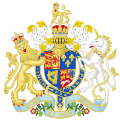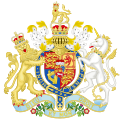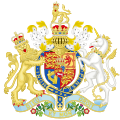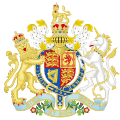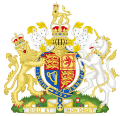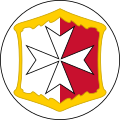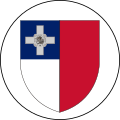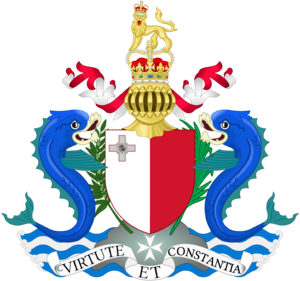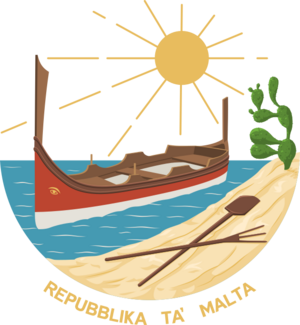Coat of arms of Malta facts for kids
Quick facts for kids Coat of arms of Malta |
|
|---|---|
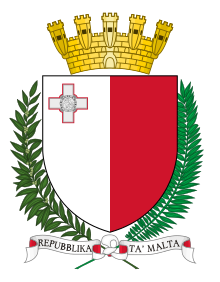 |
|
| Versions | |
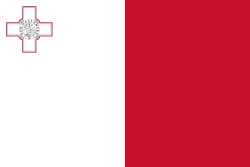
The banner of arms, which serves as national flag
|
|
| Armiger | Republic of Malta |
| Adopted | 28 October 1988 |
| Crest | A mural crown with a sally port and five vedettes. |
| Blazon | Flag of Malta: Per pale argent and gules, a representation of George Cross argent fimbriated gules in Dexter Chief |
| Supporters | Dexter, An olive branch; sinister, a palm branch in vert all in their proper colours, tied at base with a ribbon argent, backed gules and upon which is written in capital letters sable the name of the country in the Maltese language. |
| Motto | Repubblika ta' Malta |
The coat of arms of Malta is the official symbol of the country of Malta. It's like a special picture that represents the nation.
The current coat of arms was chosen in 1988. It shows a shield that looks like the national flag of Malta. Above the shield is a golden mural crown. This crown has a special gate and five small towers. These towers represent the strong fortifications of Malta and show that Malta is like a city-state.
Around the shield are two branches. One is an olive branch, and the other is a palm branch. These branches are symbols of peace and are often linked with Malta. They are tied together at the bottom with a white ribbon. On this ribbon, the words Repubblika ta' Malta are written in black. This means "Republic of Malta" in the Maltese language.
You can see the national coat of arms on many official items. It appears on passports, special stamps, and official documents. Many Maltese coins also feature the coat of arms. This includes older coins like the Maltese lira and some Maltese euro coins. It has also been shown on Maltese postage stamps.
Contents
Malta's Coats of Arms Through History
Malta has had different coats of arms over the years. Each one tells a part of the country's story.
Coats of Arms During British Rule (1800–1964)
Malta was under British rule for a long time. It was a British protectorate from 1800 to 1813. Then it became a British colony from 1813 until 1964. During this time, Malta used the official arms of Great Britain.
Malta also had three special colonial badges between 1875 and 1964. These badges were unique symbols for Malta itself.
- The first badge (1875 – around 1898) showed a white Maltese cross.
- The second badge (around 1898 – 1943) had a white and red shield. This looked like the arms of the city of Mdina.
- The third badge (1943–1964) was similar to the 1898 arms. But it had a George Cross on a blue corner of the white half.
These badges were used on Maltese state flags and the Governor's flag.
Coat of Arms After Independence (1964–1975)
Malta became an independent country on September 21, 1964. A new coat of arms was adopted then. This design showed two dolphins holding up a picture of the Maltese flag. One dolphin held a palm branch and the other an olive twig. These represented victory and peace.
Above the flag was a mural crown shaped like a fort. It had five octagonal towers. Below the shield were blue waves, showing the surrounding Mediterranean Sea. There was also a Maltese eight-pointed Cross. This cross represented Malta's connection to the Order of St. John. It also stood for courage and determination. The ribbon under the shield had the motto Virtute et Constantia. This means "by Valour and Firmness" in Latin. Today, this motto is used by the National Order of Merit.
There was also a special version of this coat of arms. It had a lion on a crown instead of the mural crown. This version was used as the coat of arms for the Governor-General of Malta.
National Emblem (1975–1988)
Malta became a republic in 1975. Seven months later, on July 11, 1975, a new national emblem was adopted. This emblem was different from a traditional coat of arms. It showed a scene of the Maltese coast. You could see the rising sun, a traditional Maltese boat called a dgħajsa, a shovel, a pitchfork, and a prickly pear plant. All these symbols were connected to Malta. Below the image, the new name of the country was written: Repubblika ta' Malta.
The Prime Minister at the time, Dom Mintoff, wanted to change the 1964 coat of arms. He thought the mural crown looked too much like royalty. So, he wanted a new design for republican Malta. A design by Edward Abela was chosen. This new design was used on passports and became the official emblem of Malta.
However, this emblem was not very popular with everyone. It was not a traditional heraldic design. So, it was replaced by the current coat of arms in 1988. This happened after a new government was elected in 1987. The new coat of arms was designed by Adrian Strickland and Robert Calì.
See also
 In Spanish: Escudo de Malta para niños
In Spanish: Escudo de Malta para niños



